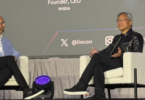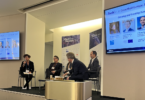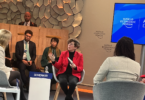5G, the high-speed fifth generation wireless technology, took center stage once again at Mobile World Congress in Barcelona February 26-March 1. The difference this year was that the focus is shifting to real-world applications such as connected cars, high-tech surgery and the Industrial Internet. Other areas in the spotlight included blockchain, cyber-security, voice-activated assistants, AR/VR, the Internet of Things and a new material called graphene.
5G:
Along with a flurry of announcements by carriers and chipmakers Barcelona reinforced its bid to become a testbed for 5G technology under a program called 5GBarcelona, an initiative promoted by the Regional Autonomous Government of Catalonia, the Barcelona City Council, Mobile World Capital Barcelona, the i2CAT Foundation, the Technological Centre for Telecommunications of Catalonia, Atos, and the Catalonia Polytechnic Universityt o turn the city in to a 5G digital hub:
*SEAT announced during Mobile World Congress that it will work with the Catalan Government, the Barcelona Council and Mobile World Capital among others, to develop 5G technology in a connected car prototype that will be tested next year in Barcelona. The Spanish carmaker also announced the creation of a new company, XMOBA, to invest in, test and launch high-tech mobility services in Barcelona and beyond.
*Hospital Clínic de Barcelona and Mobile World Capital presented a pilot project that will make it possible to provide remote assistance for surgical procedures in real time. The pilot project will be conducted in Optimus, one of the most advanced operating rooms in the world, an integrated, robotic, and digital operating theater located in Hospital Clínic de Barcelona. A solution is already being tested that audiovisually records all that happens in the operating room, from every possible angle, and sends this information live to the outside of the operating theater. Real remote mentoring based on 5G technology will enable a specialized surgeon to guide a surgeon in an operating room without being physically present and in real time. 5G could eventually enable universal, remote access to the best specialists in the world. Some 143 million surgical procedures are currently not performed across the globe due to a lack of knowledge of specific procedures, according to data given by the medical journal The Lancet.
*Spanish conglomerate ACCIONA and Mobile World Capital Barcelona signed an innovation agreement for the use of 5G networks to develop pilot industrial Internet projects in Barcelona in ACCIONA’s sectors of activity (construction, renewable energy, water and services). This collaboration agreement, with an initial duration of three years, will give ACCIONA access to 5G networks that will not be commercially available until early in the next decade.
The first projects under the innovation agreement will be carried out with telecommunications operator Orange and will consist of 5G network applications in driverless machinery on civil engineering projects and for logistics tasks at industrial plants.
To make it possible to conduct these pilot projects, Orange will offer an initial roll-out using LTE-M (pre-5G) technology to enable ACCIONA to test the use cases and implement improvements between 2018 and the full roll-out of 5G.
In the application for civil engineering projects, ACCIONA will test the use of 5G networks in both self-driving and remotely operated machinery. For self-driving machinery, 5G networks enable all the computing power to be located in the cloud (requiring the transfer of a huge volume of data, not feasible over 4G), making it unnecessary for the processors to be physically installed in each machine, which will cut costs. In the case of remotely operated machinery, the new bandwidth will make it possible to operate equipment remotely in real time, eliminating latency issues.
Among the advantages of these applications of 5G networks in construction are the reduction of workplace risks, faster execution times and the possibility of creating a centralized team of specialists in operating machinery of this type that will not have to travel to each ACCIONA work site but may work remotely.
With regard to logistics, ACCIONA proposes to automate loading and transport processes in automobile assembly plants. To this end, it will use collaborative and autonomous robots with the capacity to detect and avoid obstacles.
Blockchain:
The telecom industry is poised to size the greatest share of value from the implementation of blockchain technology, says the global consultancy Accenture in a report released at Mobile World Congress. It is recommending that communication service providers “build upon their existing ability to quickly and effectively exchange data across their collective five-billion-person network” to construct a massive asset exchange network based on blockchain. Accenture says blockchain could be a $1 trillion opportunity for the sector.
Cyber-security
Over the past two years the number of malware attacks and vulnerabilities on mobile devices have exploded, leading 4YFN, an innovation conference taking place in Barcelona at the same time as Mobile World Congress, to put cyber security on the agenda for the first time.
Voice Activated Assistants
Telefonica, which unveiled its Aura voice assistance service at last year’s Mobile World Congress, used this year’s conference to confirm the service’s launch in Argentina, Brazil, Chile, Germany, Spain and the UK. Aura is being made available on different platforms as well as Telefonica’s own, starting with Facebook Messenger in Germany and Chile. In the coming months, it will be integrated with Google Assistant and by 2019 will also work with Microsoft’s Cortana. Telefonica additionally said that Aura will power Movistar Home, a hub that connects and manages multiple devices in the home. The product will initially launch in Spain in autumn 2018. Meanwhile, visitors to Mobile World Congress were able to experience the integration of Amazon’s voice-activated service Alexa in a SEAT Ateca model on display on its stand. Amazon Alexa will enable SEAT drivers, using voice commands, to optimize their time while in their car by doing things like managing their personal schedule, finding songs, locating points of interest, real-time news or the nearest dealership, among many other functions. What will take-up of voice-activated assistants — which is projected to more than double this year globally — mean for the telecoms industry? Consumers may rely less on their mobile phones while on the go and at home. Those who own in-home digital voice assistants use their mobile phones less often for entertainment and online purchasing, according to one recent study.
AR/VR
AR/VR applications were not as present this year at Mobile World Congress. That said, mobile operator Telefonica announced a project to bring its Movistar+ TV programming to a virtual reality environment. The initiative works with most current virtual reality platforms, including smartphone-powered devices. It places viewers in a virtual room where they can watch a TV screen, interact with other avatars and see related social media content on “floating” screens.
Industry analysts CCS Insight warns that there are significant costs in content creation, production, editing and distribution in virtual reality formats. There are also the questions of how the media industry can make money from virtual reality and whether viewers will commit to wearing a headset to watch TV. Nevertheless, CCS Insights says it believes that 360-degree content will achieve a breakthrough in 2018 as the likes of BT Sport move to broadcast live sport in the format.
IoT
Mobile operator Vodafone announced V-Home by Vodafone which brings together the operator’s consumer Internet of things system and Samsung’s SmartThings platform. It will launch in Spain and Germany in the second quarter of 2018, arriving in other markets later in the year. Initially, the service will heavily focus on security, with products including cameras, sensors and monitors. Other mobile operators that have launched commercial Mobile IoT services, include AT&T, Telstra and Verizon , as well as China Mobile, China Telecom, China Unicom, Deutsche Telekom, KT and Turkcell.
Last year the GSMA today announced that mobile network operators are set to benefit from an estimated $1.8 trillion Internet of Things (IoT) revenue opportunity by 2026 boosted by the early deployment of commercial Low Power Wide Area Networks in licensed spectrum, Connected home , consumer electronics and connected car technologies are among the biggest revenue opportunities for IoT.
Graphene:
Uses for graphene, a super thin, wonder material made up of carbon atoms that are layed together in hexagonal shapes, were highlighted in a booth at Mobile World Congress this year. The mobile industry is interested because graphene could usher in entirely new types of connected devices and also be used to develop new types of optical communications. The material should be on every executive’s radar because other potential uses include purifying water, dairy products or wine; production of pharmaceuticals; separating unwanted gases from industrial, commercial and residential emissions; replacing human bones and body parts that require electricial current, like organs and nerves;improving building materials like concrete and aluminum by making them stronger and lighter; making pipes and storage tanks corrosion-resistant; developing stronger adhesives; creating flexible, low-cost, transparent solar cells that can turn virtually any surface into a source of electric power and building bigger and lighter wind turbines.







